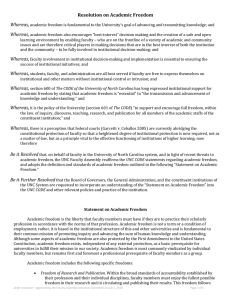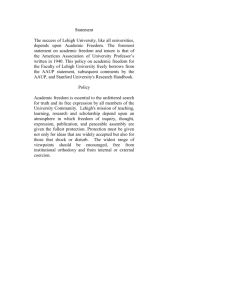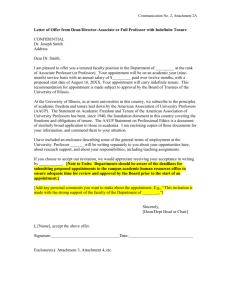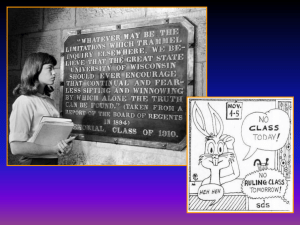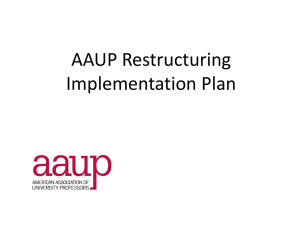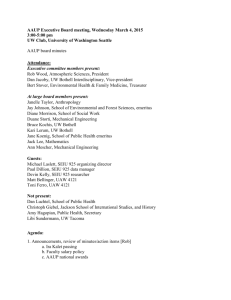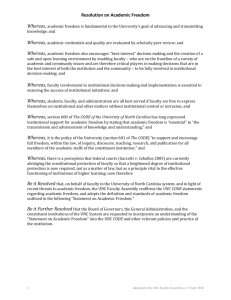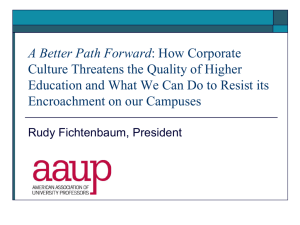Statement on Academic Freedom
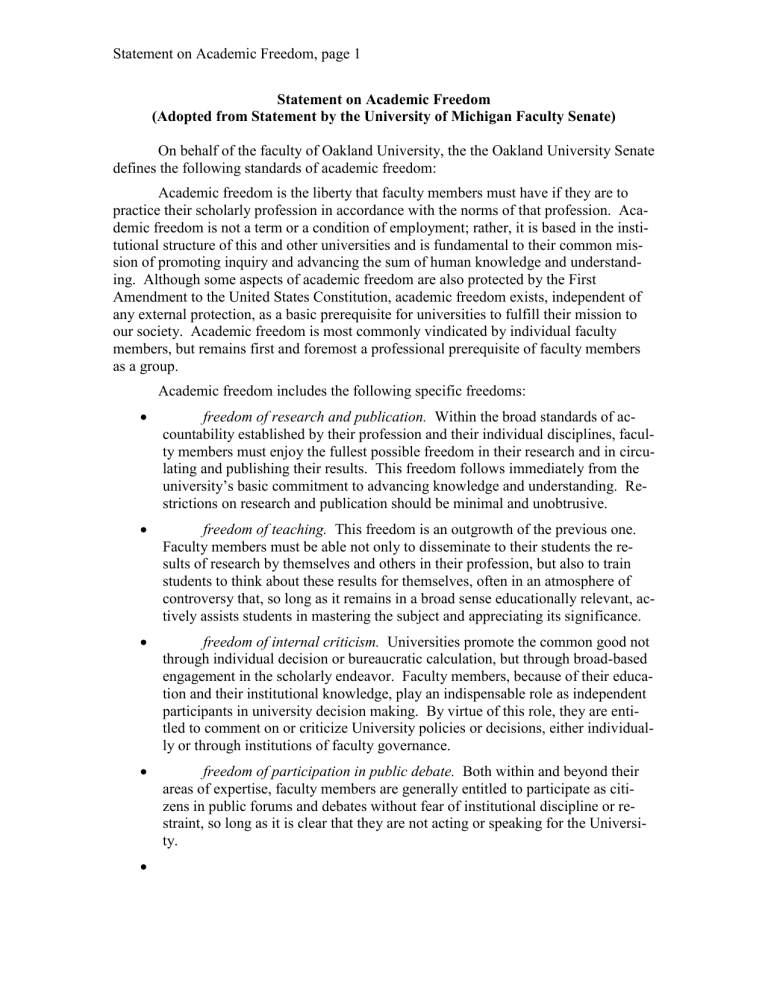
Statement on Academic Freedom, page 1
Statement on Academic Freedom
(Adopted from Statement by the University of Michigan Faculty Senate)
On behalf of the faculty of Oakland University, the the Oakland University Senate defines the following standards of academic freedom:
Academic freedom is the liberty that faculty members must have if they are to practice their scholarly profession in accordance with the norms of that profession. Academic freedom is not a term or a condition of employment; rather, it is based in the institutional structure of this and other universities and is fundamental to their common mission of promoting inquiry and advancing the sum of human knowledge and understanding. Although some aspects of academic freedom are also protected by the First
Amendment to the United States Constitution, academic freedom exists, independent of any external protection, as a basic prerequisite for universities to fulfill their mission to our society. Academic freedom is most commonly vindicated by individual faculty members, but remains first and foremost a professional prerequisite of faculty members as a group.
Academic freedom includes the following specific freedoms:
freedom of teaching.
This freedom is an outgrowth of the previous one.
Faculty members must be able not only to disseminate to their students the results of research by themselves and others in their profession, but also to train students to think about these results for themselves, often in an atmosphere of controversy that, so long as it remains in a broad sense educationally relevant, actively assists students in mastering the subject and appreciating its significance.
freedom of research and publication.
Within the broad standards of accountability established by their profession and their individual disciplines, faculty members must enjoy the fullest possible freedom in their research and in circulating and publishing their results. This freedom follows immediately from the university’s basic commitment to advancing knowledge and understanding. Restrictions on research and publication should be minimal and unobtrusive. freedom of internal criticism. Universities promote the common good not through individual decision or bureaucratic calculation, but through broad-based engagement in the scholarly endeavor. Faculty members, because of their education and their institutional knowledge, play an indispensable role as independent participants in university decision making. By virtue of this role, they are entitled to comment on or criticize University policies or decisions, either individually or through institutions of faculty governance.
freedom of participation in public debate.
Both within and beyond their areas of expertise, faculty members are generally entitled to participate as citizens in public forums and debates without fear of institutional discipline or restraint, so long as it is clear that they are not acting or speaking for the University.
Statement on Academic Freedom, page 2
Since academic freedom derives from the institutional structure of American universities, it is qualified in various respects. However, when academic freedom is so qualified, it is of critical importance that restrictions be drawn up and implemented with substantial faculty input, in such a way as to minimize infringement of academic freedom.
In large part, this goal should be accomplished by ensuring that institutional discipline of faculty members is in proportion to the severity and persistence of misconduct, and by insisting that alleged offenses be handled with appropriate standards of due process, including, wherever possible, the judgment of competent peers. For the rest, however, it must be recognized that contemporary threats to academic freedom are constantly evolving. This University — its faculty, administration, and students alike — must exercise constant vigilance in resisting such threats, whether they arise within the university or from outside.
Commentary
Bibliography. The conception of academic freedom articulated in this document derives chiefly from two statements issued by the American Association of University
Professors (AAUP): the 1915 Declaration of Principles on Academic Freedom and Academic Tenure and the 1940 Statement of Principles on Academic Freedom and Tenure , with the 1970 Interpretive Comments on this statement. These fundamental statements are now supplemented by “Protecting an Independent Faculty Voice: Academic Freedom after Garcetti v. Ceballos
,”
Academe 95 (Nov./Dec. 2009) 67-88. (All three documents are available on-line at the AAUP website.) Our formulations of this conception are heavily influenced by Matthew W. Finkin and Robert C. Post, For the Common Good:
Principles of American Academic Freedom (Yale Univ. Press, 2009), which also discusses at length cases arising under the AAUP principles. For contemporary sources of pressure on academic freedom, we have relied primarily on Robert O’Neil,
Academic Freedom in the Wired World: Political Extremism, Corporate Power, and the University
(Harvard Univ. Press, 2008). Stephen H. Aby and James C. Kuhn IV, Academic Freedom: A Guide to the Literature (Greenwood Press, 2000), contains an extensive, fully annotated bibliography. A much longer (but unannotated) bibliography is Terrance Karran, Academic Freedom: A Research Bibliography (2009), available at http://eprints.lincoln.ac.uk/1763/.
Scope of statement.
For purposes of this statement, faculty members are the all persons holding academic titles defined in Article IV of the Faculty Agreement Although the AAUP’s 1940 statement associates academic freedom with tenure, it needs stress that academic freedom applies equally to all faculty members, regardless of rank or tenure.
However, those faculty who serve the University as senior officers or administrators, or who are on their immediate staffs, are normally expected to support publicly the University’s policies, procedures, goals, and programs; therefore they have more limited freedom to speak about these matters without institutional restraint or discipline.
Other non-faculty claims to academic freedom.
The present statement, although applicable only to faculty members, does not preclude other claims. Above all, the Oakland University itself, as an institution of higher learning, has an independent claim, long recognized both in national and state law, to institutional academic freedom and autono-
Statement on Academic Freedom, page 3 my, the freedom to budget, hire, select students, determine curriculum, set salaries, and so on. Further, by virtue of their participation in the process of education, other nonfaculty members of the University community, such as clinicians, researchers, and students, also have legitimate claims to academic freedom, by analogy with the present statement (necessary changes having been made).
Academic freedom and free speech.
This statement adopts the stance of the 1915
AAUP Declaration , which describes academic freedom not as an individual protection from any and all constraints, but rather as the freedom to pursue a scholarly profession in accord with the standards of that profession. As the Declaration states, academic freedom is meant to defend “not the absolute freedom of utterance of the individual scholar, but the absolute freedom of thought, of inquiry, of discussion and of teaching, of the academic profession.” See Finkin and Post, 38-39. In this respect, academic freedom is distinct from the constitutional right to free speech as guaranteed by the First Amendment to the Constitution. However, in some instances modern courts have construed the right to free speech as protecting aspects of academic freedom, particularly within public universities. The present statement is occasioned, in part, by a perception that federal courts are currently abridging the constitutional protection of faculty, so that a heightened degree of institutional protection is now required. See O’Neil, 43-77, and also the AAUP’s 2009 article cited above, which makes the point that, because of a number of recent judicial decisions permitting university administrators to treat faculty members on the model of ordinary employees, “the case for academic freedom at both public and private institutions [should now be made], not as a matter of law, but as a principle vital to the effective functioning of institutions of higher learning.”
Professional standards of accountability.
As has often been observed, the
AAUP’s conception of academic freedom accords with normal practice at American universities, where faculty members are, for instance, hired and promoted in large part based on evaluations by their peers, including faculty members at other institutions. Today, however, a substantial amount of scholarship either questions or disregards traditional disciplinary boundaries, and this perspective, too, has become a regular part of the academic profession. The present statement is not meant to inhibit such scholarship.
Qualifications on academic freedom.
Assertions of academic freedom can come into conflict with other basic institutional values of a modern university. Academic freedom is not a defense against allegations of professional misconduct in research or teaching, nor does it provide complete protection against illegal or otherwise justifiably prohibited conduct or speech, particularly if it significantly disrupts teaching, research, administration, or other authorized activities on the campus. Academic freedom would not, for example, provide a defense to harassment of a student, nor would it in itself justify offensive speech in a classroom that is irrelevant to the subject matter being taught. Further, although academic freedom entails a high degree of faculty autonomy in organizing and teaching courses, it may also be limited by the requirements of curricula and of responsible teaching and collegiality, within an environment of tolerance and mutual respect. For example, as the AAUP acknowledged in its 1940 Statement , faculty members
“should be careful not to introduce into their teaching controversial matter which has no relation to their subject.” Finally, academic freedom is not inconsistent with reasonable institutional regulation of such areas as the performance of externally sponsored research,
Statement on Academic Freedom, page 4 the conduct of research on human subjects, the use of the University’s logo and trademarks, the deposit of faculty research in computer archives, and so on; but such regulation must be tightly defined so as to ensure that they are justified by important university policies, that they do not reflect hostility to particular viewpoints, and that they restrain academic freedom no more than is necessary.
Academic freedom and disciplining faculty members.
The primary thrust of the
AAUP’s statements on academic freedom is that faculty members are not ordinary employees subject to the usual discipline of the American workplace. Rather, because of the nature of the educational enterprise, they are more accurately described as “appointees”
(1915 Declaration ) or “officers” (1940 Statement ) of the institutions they serve; therefore administrative retaliation for the exercise of academic freedom is impermissible. In accord with this view, faculty members play a large role in disciplinary procedures at the
University; they provide the sole membership of grievance panels, and they also comprise the SACUA Tenure Committee which sits on all Bylaw 5.09 cases for removal of tenure, demotion, and dismissal of faculty members. In fulfilling this function, faculty members, when hearing and deciding cases, are expected to know and implement the present statement; and the institutions of faculty governance should also periodically review and update this statement so as to provide it with currency. In addition, the issue of whether faculty disciplinary proceedings across the University adequately protect academic freedom should be the subject of thorough consideration as current grievance and disciplinary procedures are revamped.
Threats to academic freedom.
These threats, which are described and documented at length in O’Neil’s book, are constantly evolving as universities respond to a changing world. For instance, over the past several decades various universities have experienced an internal drift toward political orthodoxy and intolerance of dissent; this drift should be stoutly resisted, even as the bounds of orthodoxy themselves shift. Recurrent as well are the conflicts between a university’s claims to autonomy and authority on the basis of its academic freedom, and faculty claims to independence on the basis of their own freedom. However, larger long-term dangers to academic freedom are now emerging, and they are often less easy to recognize and diagnose. These dangers include, for instance, increasing legal intrusions (both judicial and administrative) on independent faculty research; controversies stemming from the ubiquity of modern media, in particular the internet; the attempts of corporate sponsors to control university-based research; the efforts of self-appointed watchdogs to harass individual teachers through websites and blogs; and demands that universities demonstrate political “balance” when appointing faculty. A great deal will depend on precisely how this and other universities adapt to their changing environment without losing hold on basic institutional values such as academic freedom. The present statement can only stress that, when these values are confronted by fresh challenges, all members of our educational community must take care not only to understand but to defend them vigorously.
